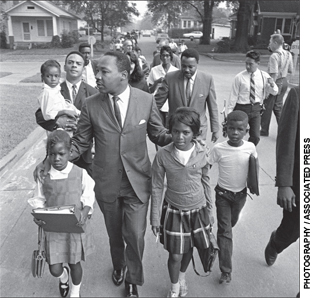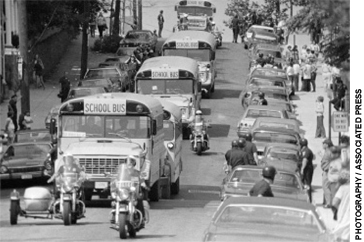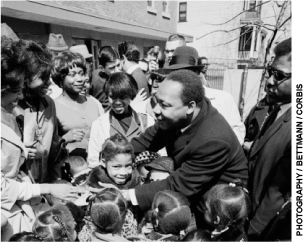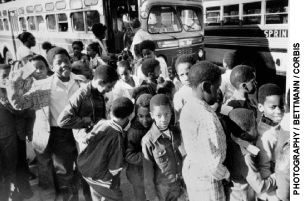Video: Susan Eaton talks with Education Next.
Video: Steven Rivkin talks with Education Next.

The Supreme Court declared in 1954 that “separate educational facilities are inherently unequal.” Into the 1970s, urban education reform focused predominantly on making sure that African American students had the opportunity to attend school with their white peers. Now, however, most reformers take as a given that the typical low-income minority student will attend a racially isolated school, and the focus, under the banner of “No Excuses,” is to make high-poverty, high-minority schools effective. What role should racial desegregation play in 21st-century school improvement? In this Education Next forum, Susan Eaton, research director at the Charles Hamilton Houston Institute for Race and Justice at Harvard Law School, makes the case for refocusing school reform on creating integrated schools. Steven Rivkin, professor of economics at Amherst College, questions whether desegregation efforts fulfilled their promise and points out complexities to the issue that researchers have barely begun to examine.
EN: In which ways did the school desegregation movement succeed? Fail?
Susan Eaton: The school desegregation movement improved educational opportunities for students of color, particularly for black students in the South. It also created a generation of people for whom diversity was the norm.
The movement did not fail. Rather, government failed to actively support desegregation and, during the Nixon and two Bush administrations, actively worked against it. Not long after Brown, the courts began backing away from desegregation as a means toward equal educational opportunity. The rollback started with the Milliken v. Bradley decision in 1974, which prohibited the incorporation of suburbs into urban desegregation plans. This meant that in the North and Midwest especially, exclusive white suburbs were exempted from desegregation, even if their zoning and other housing policies had contributed to segregation in the region.
Desegregation’s critics hold it to too high a standard, implying that unless desegregation solves all educational challenges, it is not worth the trouble. No policy could survive such a test. Desegregation was never meant to be a remedy for low test scores. Rather, it was and is one underlying condition with the potential to engender higher-quality schooling, improved race relations, and, in the long run, a more democratic, more equal society.
Diverse schools committed to equal opportunity hold vast, often untapped potential, but it is up to teachers, parents, administrators, and other sectors of society to harness it. When diverse schools institute rigid academic tracking that places students of color in low-level classes or employ harsh discipline policies that exclude students rather than providing support, they are not truly integrated. The success of today’s diversity movement hinges on our ability to move diverse schools closer to true integration.
Increasing linguistic and cultural diversity enriches our society. A modern integration movement must incorporate immigrant students and English language learners. The sharp segregation of these groups from mainstream opportunity limits their chances for social mobility and encourages prejudice against them.
Steven Rivkin: Desegregation efforts did improve the racial balance of public schools. Although demographic changes tempered the effects somewhat, school enrollment data show substantial changes in the racial makeup of schools after 1968. The South experienced the largest increase in school integration and the Northeast the smallest. Nationally, the share of African American students’ schoolmates who were white rose from 22 to 36 percent between 1968 and 1980 before falling to roughly 30 percent in 2000. The decline in this measure during the 1990s resulted from the continued decline in the white enrollment share.
The most striking changes occurred at the bottom of the distribution, as the share of African American students attending schools with fewer than 5 percent white students fell by more than 50 percent after 1968.
Other effects are difficult to identify with certainty. Desegregation programs in some cities prompted “white flight,” although over the long run it appears to have had only a small effect on housing patterns in most communities. The evidence on academic, labor market, and social outcomes is sparse.
What I believe can be said is that desegregation failed to be the panacea some believed it would be. The expectation that desegregation would dramatically reduce or eliminate racial achievement gaps was unrealistic given the myriad differences in family, school, and community circumstances. The persistent education and earnings gaps are all too visible, as are the higher rate of incarceration among young black men compared to white men and the much higher rate of teen childbearing for young black women compared to white women.
The key question is whether specific desegregation programs brought improved outcomes for African Americans. Unfortunately, there is little good evidence to bring to bear on this question. The persistent, large outcome gaps and waning support for desegregation do provide grounds for exploring other policies, including enriched early-childhood education and substantially different models for delivering elementary and secondary education.

EN: Is desegregation even politically and legally feasible in 2010? Why not focus on integrating schools by class rather than by race?
SR: The legal impediments to desegregation by race are formidable. Desegregation advocates may ask state courts to impose desegregation orders based on constitutional guarantees for an adequate education, as has been the case in Connecticut. But the extent to which state constitutions provide support for desegregation by race is unclear.
The political climate also shows declining support for race-based remedies. A number of states, including California, have passed referenda that prohibit the use of race by schools and other public institutions to distinguish among applicants. In addition, African American and Hispanic support for desegregation appears to be declining.
Many large cities and their systems of neighborhood public schools are extensively segregated by income. The expansion of charter and magnet schools, along with private school options, does provide some opportunities for children in high-poverty areas to attend schools that are more mixed in terms of class and income. Yet the decision by a small number of children to opt out of neighborhood schools may adversely affect the academic and social environment in those schools, as the remaining children are likely to have less-involved families on average. An income desegregation program that involves all students may avoid the concentration of children with fewer family resources in particular schools.
A number of districts across the country have moved to equalize across schools the share of poor students, as measured by eligibility for subsidized lunch. Although African American and Hispanic children are more likely than whites to be eligible for a subsidized lunch in most communities, poverty crosses racial and ethnic lines, and desegregation by income produces a very different result than would a policy of racial desegregation.
Evidence on the achievement effects of desegregation by income is limited by both an absence of detailed information on family income (including indicators for severe poverty or high income) and the difficulty in separating the effects of students’ own circumstances from the influences of peers. It is not surprising therefore that findings are mixed. The landmark 1966 Coleman Report highlighted the importance of peer environment along a number of dimensions, but work by Caroline Hoxby and Gretchen Weingarth in 2006 suggests that the share of poor students has only a modest effect on achievement once differences in the prior achievement of students have been accounted for. However, lower peer achievement is a potentially important channel through which a high poverty rate could affect the educational environment, and from a policy perspective what matters is the total effect of a high poverty rate. That includes any effect of student poverty on teacher quality; in a 2004 study, Eric Hanushek, John Kain, and I found that poverty contributes to teacher turnover and to schools having a higher share of teachers with little or no prior teaching experience.
In comparison to poverty rate, measures of socioeconomic status (SES) and parental education appear to be more closely related to achievement and other outcomes. In a 1991 study at the high-school level, Susan Mayer found that attendance at a high-SES high school reduces teen pregnancy and the probability of dropping out. And in a 2002 study that accounts for observed and unobserved school and family influences, Patrick McEwan found that achievement appears to be more strongly related to the average education level among the mothers of children in the school or classroom than to average income. It may be that parental education provides a better proxy for the level of parental support or student engagement than the available poverty measures.
Importantly, even if these or other studies succeed in isolating the causal effects of peer SES, they do not provide direct evidence on the effects of specific income desegregation efforts. Exposure to higher SES peers, accomplished through school busing, may produce very different effects than exposure through family choice of neighborhood. Just as is the case with racial integration, it is imperative to gather additional evidence as part of any efforts to desegregate by income or SES more generally defined.
SE: Secretary of Education Arne Duncan recently stood at the Edmund Pettus Bridge in Selma, Alabama, and said, “I think Dr. King would have been disheartened to see that 56 years after the Supreme Court decided Brown v. Board of Education, many schools are still effectively segregated in America. Everywhere we go, people want to know how we can best help children. We often get asked, ‘How can we better integrate our schools, promote a healthy diversity, and reduce racial isolation?’”
In Parents Involved in Community Schools v. Seattle School District No. 1 (2007), the U.S. Supreme Court reaffirmed as compelling government interests both the attainment of racial diversity and the avoidance of segregation in schools (see “Affirmative Action Docketed,” legal beat, Winter 2007). In his controlling opinion, Justice Kennedy laid out several means through which educators could reach those goals. These included siting schools so that they might draw from demographically distinct neighborhoods and recruitment in neighborhoods of color or in white neighborhoods to create a diverse mix of students, among other possibilities.
If the goal is to provide truly equal educational opportunities to all children, then opportunity is what we should measure and lack of opportunity what we should seek to remedy. Each community needs an accurate assessment of who does and does not have access to high-quality education. Inequality in access goes far beyond socioeconomic status, and reliable measures would incorporate a more granular understanding of what limits educational opportunities. To this end, the Kirwan Institute for the Study of Race and Ethnicity at the Ohio State University has developed a system of “Opportunity Mapping” that assesses the access people have to conditions that either support or undermine economic and educational opportunity. They often find that people of color are still disproportionately locked out. Findings like this demonstrate the need to keep race and past and present racial discrimination an explicit part of conversations and policy efforts related to schools, transportation, health, and housing.

EN: In a world of limited resources, what’s the argument for trying to create racially or socioeconomically integrated schools, rather than making high-poverty, high-minority schools more effective?
SE: Educators have long testified and research has long demonstrated that schools with large shares of economically disadvantaged children become overwhelmed with challenges that interfere with education. Racially segregated high-poverty schools tend to be overrun with social problems, have a hard time finding and retaining good teachers, are associated with high dropout rates, and are less effective than diverse schools at intervening in problems outside of school that undermine learning. In a longitudinal study of dropout rates, researcher Argun Saatcioglu concluded, “desegregated schools likely played a more effective role in counterbalancing student-level nonschool problems than did segregated ones.” Generally, racially and economically diverse schools have been far more successful than segregated ones in improving achievement, graduating students of color, and sending kids to college. There are some successful high-poverty schools, certainly, but hardly enough to make “separate but equal” our education policy.
Not since the Johnson administration has the United States had a firm commitment, through rhetoric and action, to school integration. In 2007, 64 percent of African American and 63 percent of Latino students attended high-poverty schools. Only 21 percent of white children attended such schools. Government spends most of its education money trying to make “separate but equal” work. Separate but equal has never worked. Growing inequalities in the society are replicated in school hallways and classrooms.
We need to continue to spend money improving curriculum and conditions and providing teacher training and enrichment offerings in challenged high-poverty schools. A balanced, forward-looking education policy would also act on decades of research findings and the experience of educators on the ground, who know that children of all races and backgrounds tend to reap huge benefits from attending racially and economically diverse schools.
SR: This question posits a choice between two policies, when in fact a more nuanced approach that varies from place to place is likely to be more effective.
It is possible that assigning students to schools with an eye to equalizing the socioeconomic, rather than the racial, mix across schools may confer benefits on children that outweigh any additional transportation costs. Because educational needs are higher on average for children in low-income families, the concentration of poverty in particular schools tends to increase their financial and programmatic burden. There is also evidence that schools with a higher poverty rate experience more disruptive behavior among students. High-poverty schools may be at a disadvantage in hiring and retaining effective teachers as well.
Yet there may be education reforms such as expanded school choice that both increase segregation by income or race and improve the quality of education for minority and low-income children, particularly given the increasingly stringent limitations on government use of race or ethnicity in student assignment. The recent Supreme Court decision, Parents Involved in Community Schools v. Seattle School District No. 1, ruled unconstitutional the Seattle and Louisville school districts’ limited use of race in deciding which students got into overenrolled schools (Seattle) or which students could transfer schools (Louisville), limiting the scope of government intervention to preserve racial balance following the expansion of school choice. In the absence of race-based constraints, some reform efforts that aim to improve school quality, such as charter schools, open enrollment, magnet schools, and vouchers, may intensify segregation by income, race, or achievement (see “A Closer Look at Charter Schools and Segregation,” check the facts, Summer 2010). However, if the concentration of minority or low-income students in a school results from the purposeful choices of parents rather than from neighborhood segregation, the adverse effects may be fewer.

EN: What’s the evidence that desegregation leads to academic benefits for poor or minority students? Are these benefits large enough to justify the expense?
SE: Evidence from a variety of fields—education, public health, and economics—supports attaining and maintaining diversity and avoiding racial and economic isolation in schools. In the last decade, research on these questions grew more robust. As data and statistical methods improved, researchers were able to disentangle the intertwined influences of school, home, and neighborhood.
The weight of social science evidence demonstrates that racially diverse schools are associated with achievement in math and reading, better critical thinking, and increased intellectual engagement for students from all racial groups. A 2006 study by Douglas Harris used data from 22,000 schools to find that the Latino and African American gains in math were far greater in diverse schools than in segregated ones. A 2010 study by Mark Berends and Roberto Penaloza of longitudinal data over 30 years demonstrates a relationship between increasing segregation of black and Latino students and growth in math achievement gaps between these groups and white students. As for reading, a 2006 study by Shelly Brown-Jeffy found that diverse high schools (25 to 54 percent students of color) have smaller racial gaps in reading than schools with either extremely high or extremely low proportions of students of color. A robust 2006 study, by Kathryn Borman and colleagues, showed that, independent of other factors, racial segregation of black students in Florida was negatively associated with reading test scores, as early as first grade.
Some desegregation plans do incur increased transportation costs. In a time of budget constraints, it is vital that we think creatively about how to create and sustain racial diversity. For example, many states allow for “open enrollment” through which students may attend schools outside of the community where they live. Such plans could become tools for diversity, through recruitment in neighborhoods of color. Charter school developers could do more to create racially and economically diverse schools by enrolling students from more than one municipality. Educators could also collaborate with public transportation officials to coordinate routes and schedules, allowing parents and students to commute together to school and work in new job centers.
Maintaining dozens of small school districts in a metropolitan area, each with its own highly paid administrators and transportation budgets, is also extremely costly. Consolidation and regionalizing several demographically distinct communities could save money in the long run and create diversity.
SR: One of the unfortunate legacies of the desegregation efforts that followed the Brown v. Board of Education decision is a lack of understanding of the impacts of various types of desegregation programs in different settings. There was no evaluation component built into the desegregation effort. Although there were some small-scale random-assignment experiments of the effects of desegregation on test scores, most of what we know today concerns the relationship between a school outcome such as achievement on the one hand, and racial composition on the other. Research, including 2008 and 2009 studies by Eric Hanushek, John Kain, and me, and a 2000 study by Caroline Hoxby that account for both observed and unobserved factors that could affect outcomes and contaminate the results, suggests that African Americans, particularly higher achievers, do benefit from attending schools with a higher proportion of white students. It is likely, though, that the benefit depends on how school integration was achieved. The relationship between achievement and the demographic composition of the classroom is not well understood. What drives higher achievement? Is it peer influences? Better teachers? Teacher behavior?
Clearly, both the student population and the quality of instruction affect student outcomes, and policies should take both factors into consideration.

EN: What are the nonacademic benefits of desegregation, particularly for poor and minority students?
SE: In his seminal 1972 study titled Inequality, the Harvard-based sociologist and statistician Christopher Jencks wrote, “The case for or against desegregation should not be argued in terms of academic achievement. If we want a segregated society, we should have segregated schools. If we want a desegregated society, we should have desegregated schools.” This basic, blunt statement would hold true through the decades, while researchers repeatedly examined statistics and conducted research reviews and in-depth interviews to test something sociologists call “perpetuation theory.” Perpetuation theory posits that people who attend desegregated schools will continue to opt for racially diverse settings later in life and will use skills learned in school to more successfully navigate such settings.
Research has consistently found support for this powerful idea. In 2007, the National Academy of Education concluded that “early experience in desegregated schools tends to reduce expectations of hostility, improve skills and comfort with interracial settings, and create a tolerance for—if not a preference for—subsequent desegregated educational settings.” Reviewing research spanning 25 years, the Academy found a consistent association between early desegregated schooling experience and later working in desegregated work places, living in desegregated neighborhoods, and people’s perception that they acquired skills that made them more effective and able to persist in racially diverse settings.
For students of color, in particular, this means that attendance at a desegregated school tends to make them more likely to enter and persist in white-dominated or racially diverse settings when they perceive opportunity there. This was a basic finding from my interviews with adult graduates of Boston’s voluntary city-suburban school desegregation program, METCO (recounted in The Other Boston Busing Story, Yale University Press, 2001). In 2008, Columbia University professor Amy Stuart Wells and her colleagues published interviews with adults from a variety of backgrounds who had attended desegregated schools across the country. They concluded, “desegregation made the vast majority of the students who attended these schools less racially prejudiced and more comfortable around people of different backgrounds.”
SR: Potential nonacademic benefits include expanded access to job networks, more interracial friendships, and enhanced access to educational networks, including private schools and colleges. Although some research finds that such benefits exist, the available data have not permitted researchers to confirm the causal effects of desegregation on nonacademic benefits for the same reasons that it is difficult to produce convincing findings on academic benefits: the nonrandom sorting of students among school environments and the real possibility that forced busing may produce effects very different from those of living in a racially or socioeconomically mixed community.

EN: Is school desegregation dead? Either way, what do you foresee in school racial makeup when you look out a generation?
SR: Although any new efforts based on federal law are likely to be limited, it may be premature to pronounce school desegregation dead. Districts will no doubt continue to monitor school enrollment patterns and enact rules and programs designed to foster racial integration, even if indirectly.
At the root of school segregation is extensive residential segregation. Transporting students long distances to reduce segregation in schools is costly, time-consuming for students, and likely to reduce parental participation in the schools. Targeting additional resources to early childhood education, extended day, summer programs, prudent class-size reduction, or enhanced accountability structures is likely to have a higher return in these communities than racial desegregation efforts.
Over time, a number of forces will combine to determine the school enrollment landscape. The dismissal of court-ordered plans will likely increase segregation, though modestly; the expansion of school choice will likely have a similar effect. Residential segregation may decline somewhat in most regions of the country, but residential segregation by race and income will almost certainly remain a defining feature of the U.S. and a sizable impediment to greater school integration. Given this housing pattern and the declining share of elementary and secondary school students who are white, African American students are likely to have fewer white and more Hispanic and Asian classmates in the years to come.
SE: School desegregation is vibrant, alive, and also vulnerable. Through my work, I’m lucky to meet and collaborate with educators and families who are creating, sustaining, and improving racially diverse schools. For example, in Hartford, Connecticut, a legal decision created a system of regional magnet schools that attract students of color from the impoverished city and students from the working-class towns and affluent suburbs that surround it. In Boston, Palo Alto, and St. Louis, students from the city voluntarily board buses to attend suburban schools. In Louisville, Kentucky, educators employed Opportunity Mapping and decided to retain a school choice system that achieves racial diversity. In Omaha, Nebraska, cities and suburbs created a joint tax-sharing program to fund schools that bring together students from across the region. In Montclair, New Jersey, a racially diverse group of parents works to strengthen magnet schools that bring together students from varying racial and economic groups. In Montgomery County, Maryland, community members develop action plans to improve opportunity for students of color and to build community in their diverse schools. The stories are endless, but not widely known.
Unless our policies begin to support diversity and true, stable integration, I foresee continuing segmentation of our residential and educational space along racial lines. Oddly, this will happen even as diversity in the larger society increases.
This article appeared in the Fall 2010 issue of Education Next. Suggested citation format:
Eaton, S., and Rivkin, S. (2010). Is Desegregation Dead? Parsing the relationship between achievement and demographics. Education Next, 10(4), 50-59.


